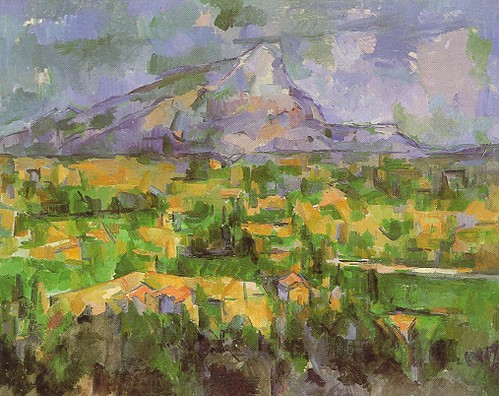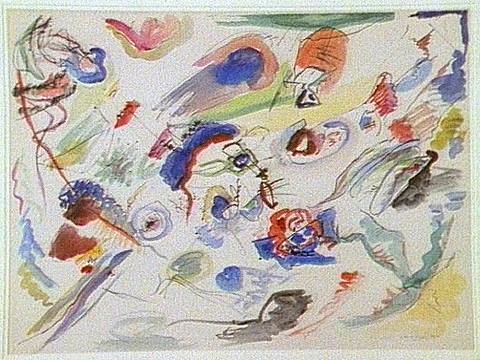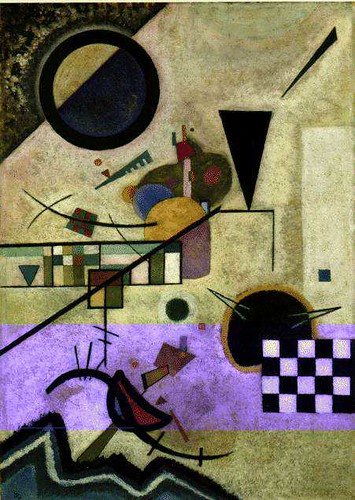Monday, April 03, 2006
(2:20 AM) | David Sneek:
Being and Event Reading Group: Meditations 31, 35 and 36
I. The set of examples Alain Badiou uses to illustrate concepts like the event and the generic procedure is not very large. The French Revolution or the Paris Commune in the domain of politics. Galileo's mathematization of nature in science. For artistic production, it is often Arnold Schönberg's invention of musical forms which shows best how something new can come into existence. He is therefore central to Meditation 35 of Being and Event, the updated Theory of the Subject: Badiou mentions Pierrot Lunaire as one of the "finite presentations" by way of which an infinite truth proceeds and writes of Schönberg as "the name of a subjectivization", like Saint Paul or Cantor; his method is a generic procedure that evaluates the statement that "the theme will no longer be the organising element of musical discourse". An opportunity for a multimedia post that moves - diagonally, of course - twice through some of the final Meditations.Gustav Mahler, Totenfeier
Mahler's symphonic universe was, according to Badiou, the evental site for Schönberg - "Palestine for the first Christians". But perhaps it is better to emphasize that the late-romantic site where atonal music appeared also includes Schönberg's own earlier compositions such as Verklärte Nacht. And the generic procedure that followed it went far beyond Schönberg's own output and was continued in the works by Anton Webern, Pierre Boulez and others. The subject of art is "mixed".
Arnold Schönberg, Verklärte Nacht op. 4
If this is the site, the event can be heard in the iconoclastic works Schönberg composed between 1909 and 1912, breaking through "every restriction of a bygone aesthetic" as he said about the song cycle Das Buch der hängenden Garten. It was followed by the Five Orchestral Pieces, Erwartung and the sequence culminated in the short song Herzgewächse, the piece Anton Webern called "der Gipfelpunkt der Musik". Dissonances are "emancipated", unusual combinations of timbres - celesta, harmonium, harp - form the accompaniement for a vocal line that leaps into new directions.
Arnold Schönberg, Herzgewächse op. 20
The twelve-tone technique that Schönberg developed after this period of creative exploration would then be the intervention upon the event. The invention of the "Method of Composing with Twelve Notes Which are Related Only to One Another", the emergence of an operator that must "force" a "situation-to-come".
Arnold Schönberg, Suite op. 25: Minuett
Forcing and fidelity: starting from the event of atonality, dodecaphony opened up the possibility, and the necessity, to re-examine everything that came before. It is in this sense that a truth is infinite. "Its procedure contains an infinity of enquiries." This process was continued by others than Schönberg. Anton Webern developed twelve-tone music into a much more abstract language, that was taken even further by the serialism of the post-war avant-garde.
Anton Webern, String Quartet op. 28: first movement
II. Same story, with JPEGs for MP3s: Schönberg's development from late romanticism to expressionism has often been compared to the move painters made at the same time from post-impressionist painting towards expressionism and abstraction.
 Paul Cézanne, Mont St. Victoire
Paul Cézanne, Mont St. VictoireIn Meditation 31 Badiou writes of the "the cubist precipitation of the Braque-Picasso tandem" as "the effect of a retroactive intervention upon the Cézanne-event." The geometry of the patterns and shapes that already dominates Cézanne's still-lifes and landscapes, takes on a life of its own in in cubism and makes the objects all but disappear. Another example of an event - unpredictable, random, aleatoric - is given in Wassily Kandinsky's Reminiscences.
Moscow, 1896. Kandinsky, a 29-year old law professor, visits an exhibition of French art in Moscow where he is shocked by one of Monet's Haystacks - the encounter that makes him decide to become a painter.
 Claude Monet, Haystack
Claude Monet, Haystack"That it was a haystack the catalogue informed me. I could not recognize it. This non-recognization was painful to me. I considered that the painter had no right to paint indistinctly. I dully felt that the object of the painting was missing. And I noticed with surprise and confusion that the picture not only gripped me, but impressed itself ineradicably on my memory. Painting took on a fairy-tale power and splendor."
Meditation 31: "As such, the class of multiples which are connected to the event will not be determined by any of the properties which can be formulated in the language of the situation. It will thus be indiscernible and unclassifiable for knowledge."
Meditation 36: "Generally, a generic part does not exist in the situation, because it cannot belong to this situation despite being included therein. An inhabitant of the situation possesses the concept of generic part, but in no way possesses an existent multiple which corresponds to this concept. She can only believe in such an existence."
 Wassily Kandinsky, First Abstract Watercolour
Wassily Kandinsky, First Abstract Watercolour"The subject generates nominations": the title of Kandinsky's first abstract painting from 1910 is also a manifesto. The name declares the independent existence of the "non-existent", of what Kandinsky had in the past thought of as his "painful non-recognization". It is a "retroactive intervention" upon the Monet-event.
 Wassily Kandinsky, Contrasting Sound
Wassily Kandinsky, Contrasting SoundLike Schönberg, Kandinsky went on to formalize the disorder of his first abstractions in a systematical way. The book Point and Line to Plane tried to make an inventarization of the minimal gestures of painting; points, curves, triangles. And from there, to rethink all of painting from the perspective of the event; to invent a language for it; to inscribe it into the encyclopedia.
Meditation 31: "However, one can 'force' a new situation to exist - a 'generic extension' - which contains the entirety of the old situation, and to which this time the generic procedure belongs (it is both presented and represented: it is normal). This point (forcing) is the step of the subject."
What existed in the old situation will still be there, but transformed, new. In Kandinsky's words: "The impact of the acute angle of a triangle on a circle produces an effect no less powerful than the finger of God touching the finger of Adam in Michelangelo."

